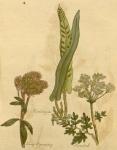A wild plant of the fern kind, that is, consisting only of leaves, without a stalk, the flowers and seeds being borne on the backs of them. But it has no resemblance to the ordinary ferns in its aspect. Each leaf of hart's tongue is a separate plant, but there rise many from the same root. The foot-stalk is five inches long, the leaf an inch and a quarter broad, largest at the bottom, and smaller to the top, usually simple, but sometimes divided into two or more parts at the end. It is of a beautiful green at the upper side, somewhat paler underneath, and the foot-stalk runs all along its middle in the form of a very large rib. The seed-vessels are disposed in long brown streaks on each side of this rib, on the under part of the leaf, and they are more conspicuous than in most of the fem kind. The plant grows in old wells, and in dark ditches, and is green all the year.
It is not much used, but deserves to be more known. It is an excellent astringent; the juice of the plant, taken in small quantities, and for a continuance of time, opens obstructions of the liver and spleen, and will cure many of the most obstinate chronic distempers.


